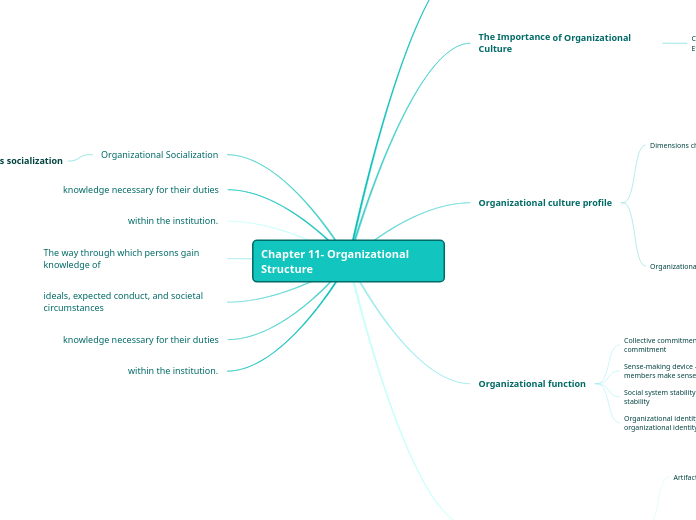によって REGINA INYANG 3年前.
256
Chapter 11- Organizational Structure

Chapter 11- Organizational Structure
ideals, expected conduct, and societal circumstances
The way through which persons gain knowledge of
within the institution.
knowledge necessary for their duties
Organizational Socialization
Stages socialization
Elements of Organizational culture
Organizational culture
-Implicit mental models,idea protoypes of behaviour
-Unconscious,taken for granted beliefs
Shared assumptions
-Evaluate what is good or bad, right or wrong
-Conscious beliefs
Shared values
Artifacts of organizational culture
Stories and legends
Rituals and ceremonies
Language
Physical structure
Organizational function
Organizational identity - Give members an organizational identity
Social system stability - Promote social system stability
Sense-making device -Shape behavior by helping members make sense of their surroundings
Collective commitment -Facilitate collective commitment
Organizational culture profile
Organizational Culture Dimensions
Aggressiveness
Outcome orientation
Respect for people
Stability
Innovation
Attention to detail
Team orientation
Dimensions characteristics
Competitive, low emphasis on social responsibility
Collaboration, people-oriented
Precise, analytic
Action oriented, high expectations, results oriented
Fairness, tolerance
Predictability, security, rule-oriented
Experimenting, opportunity seeking, risk taking, few rules, low cautiousness
The Importance of Organizational Culture
Contigencies of Organizational Culture & Effectiveness
Create an adaptive culture
External focus, process focus, ownership, proactive
Avoid strength to level of corporate cult
Cults restrict mental models, suppress subcultures
Ensure culture-environment fit
Strengthening Organizational Culture
External contraction is selling off elements of the firm
Attracting, selecting and socializing employees
Actions of founders and leaders
Aligning Artifacts
Introducing culturally consistent rewards

